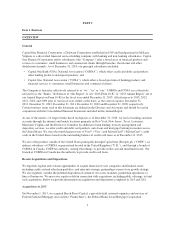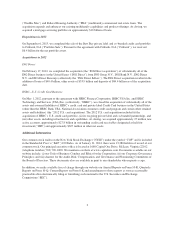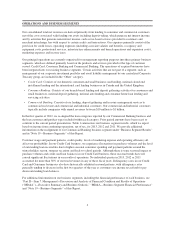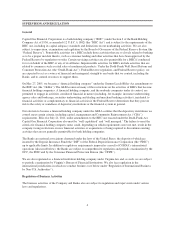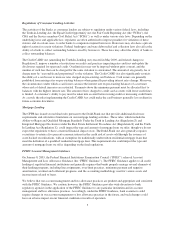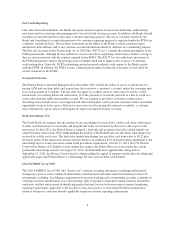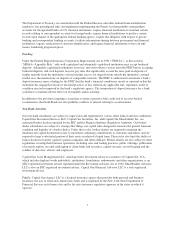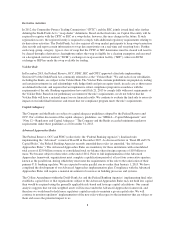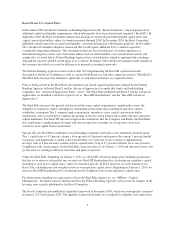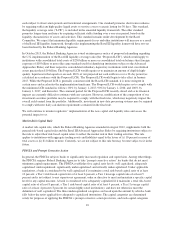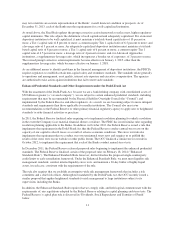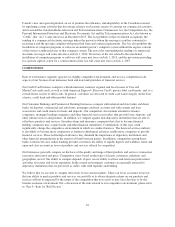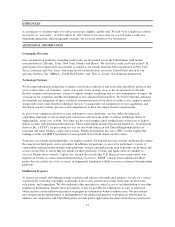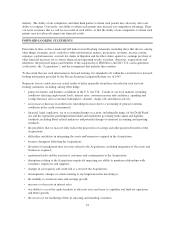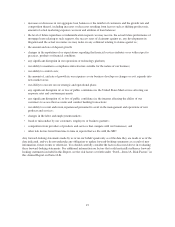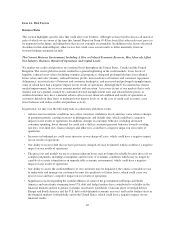Capital One 2013 Annual Report Download - page 31
Download and view the complete annual report
Please find page 31 of the 2013 Capital One annual report below. You can navigate through the pages in the report by either clicking on the pages listed below, or by using the keyword search tool below to find specific information within the annual report.may not constitute an accurate representation of the Banks’ overall financial condition or prospects. As of
December 31, 2013, each of the Banks met the requirements for a well-capitalized institution.
As noted above, the Final Rule updates the prompt corrective action framework to reflect new, higher regulatory
capital minimums. This rule adjusts the definitions of well capitalized and adequately capitalized. For an insured
depository institution to be well capitalized, it must maintain a total risk-based capital ratio of 10 percent or
more; a Tier 1 capital ratio of 8 percent or more; a common equity Tier 1 capital ratio of 6.5 percent or more; and
a leverage ratio of 5 percent or more. An adequately-capitalized depository institution must maintain a total risk-
based capital ratio of 8 percent or more; a Tier 1 capital ratio of 6 percent or more; a common equity Tier 1
capital ratio of 4.5 percent or more; a leverage ratio of 4 percent or more; and, for Advanced Approaches
institutions, a supplementary leverage ratio, which incorporates a broader set of exposures, of 3 percent or more.
The revised prompt corrective action requirements become effective on January 1, 2015, other than the
supplementary leverage ratio, which becomes effective on January 1, 2018.
As an additional means to identify problems in the financial management of depository institutions, the FDICIA
requires regulators to establish certain non-capital safety and soundness standards. The standards relate generally
to operations and management, asset quality, interest rate exposure and executive compensation. The agencies
are authorized to take action against institutions that fail to meet such standards.
Enhanced Prudential Standards and Other Requirements under the Dodd-Frank Act
With the enactment of the Dodd-Frank Act, because we are a bank holding company with consolidated assets of
$50 billion or greater (a “covered company”), we are subject to certain enhanced prudential standards, including
requirements that may be recommended by the Financial Stability Oversight Council (the “Council”) and
implemented by the Federal Reserve and other regulators. As a result, we are becoming subject to more stringent
standards and requirements than those applicable for smaller institutions. The Council also may issue
recommendations to the Federal Reserve or other primary financial regulatory agency to apply new or heightened
standards to risky financial activities or practices.
In 2011, the Federal Reserve finalized rules requiring us to implement resolution planning for orderly resolution
in the event the Company faces material financial distress or failure. The FDIC has issued similar rules regarding
resolution planning applicable to the Banks. In addition, in October 2012, the Federal Reserve issued a rule that
implements the requirement in the Dodd-Frank Act that the Federal Reserve conduct annual stress tests on the
capacity of our capital to absorb losses as a result of adverse economic conditions. The stress test rule also
implements the requirement that we conduct our own semiannual stress tests and requires us to publish the
results of the stress tests on our website or other public forum. The OCC finalized a similar stress test rule in
October 2012, to implement the requirement that each of the Banks conduct annual stress tests.
In December 2011, the Federal Reserve released proposed rules beginning to implement the enhanced prudential
standards. The Federal Reserve finalized certain of the proposed rules on February 18, 2014 (“Enhanced
Standards Rule”). The Enhanced Standards Rule, however, did not finalize the proposed single-counterparty
credit limits or early remediation framework. Under the Enhanced Standards Rule, we must meet liquidity risk
management standards, conduct internal liquidity stress tests, and maintain a 30-day buffer of highly liquid
assets, in each case, consistent with the requirements of the rule.
The rule also requires that we establish an enterprise-wide risk management framework that includes a risk
committee and a chief risk officer. Although not mandated by the Dodd-Frank Act, the OCC recently issued a
similar proposal that applies heightened standards for risk management to large institutions subject to its
supervision, including the Banks.
In addition, the Enhanced Standards Rule requires that we comply with, and hold capital commensurate with the
requirements of, any regulations adopted by the Federal Reserve relating to capital planning and stress tests. The
Federal Reserve’s capital plan rule is discussed in “Dividends, Stock Repurchases and Transfers of Funds”
below.
11


